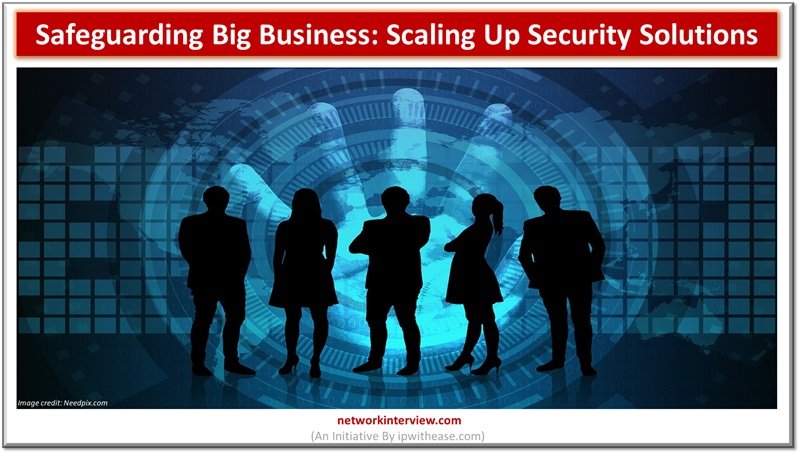
Safeguarding Big Business: A Deep Dive into Scaling Up Security Solutions
In today’s digital age, the protection of sensitive data and critical assets is paramount, particularly for large enterprises. With sprawling networks, diverse endpoints, and a plethora of applications to manage, the challenges of securing operations at scale are immense. However, amidst these challenges lie tailored solutions designed specifically to address the unique needs of big businesses, ensuring robust protection against a myriad of cyber threats.
The Complexity of Large-Scale Operations
- Multifaceted Infrastructure: Large enterprises operate across multiple locations, each boasting its own array of networks, devices, and applications. Managing this multifaceted infrastructure introduces complexity, rendering it progressively challenging to uphold visibility and control over security measures. This intricate network architecture amplifies the need for robust security solutions tailored to the specific demands of large-scale operations. By implementing comprehensive security measures that cater to the diverse needs of each location, enterprises can effectively mitigate risks and bolster their overall cybersecurity posture.
- Targeted Cyber Attacks: Big businesses are prime targets for cybercriminals due to the potential for high-value data breaches. These attackers often employ sophisticated techniques to exploit vulnerabilities, necessitating advanced security measures to safeguard against evolving threats.
Tailored Solutions for Big Businesses
- Comprehensive Security Software: Enterprise-grade security software offers a comprehensive suite of features, including advanced threat detection, encryption, access control, and centralized management capabilities. By investing in these solutions, large enterprises can establish a robust security posture that spans their entire organizational infrastructure. The definition of role based access control (RBAC) is a method of restricting network access based on the roles of individual users within an organization, ensuring that only authorized users with specific roles or responsibilities can access certain resources or perform particular actions.
- Network Segmentation: Network segmentation divides the infrastructure into smaller, more manageable segments, reducing the attack surface and limiting the potential impact of security breaches. Implementing strict access controls and monitoring traffic between segments enhances security without compromising performance.
- Cloud-Based Security Solutions: Cloud-based security solutions provide scalability and flexibility, making them well-suited for the dynamic environments of large enterprises. From cloud-based firewalls to security information and event management (SIEM) systems, these solutions offer real-time visibility and control across distributed IT ecosystems.
- Advanced Authentication Mechanisms: Passwords alone are no longer sufficient to protect against unauthorized access. Big businesses should implement multi-factor authentication (MFA) mechanisms, such as biometrics or token-based authentication, to bolster security and mitigate the risk of credential theft.
- Security Awareness Training: Comprehensive security awareness training programs educate employees about cybersecurity best practices, such as identifying phishing attempts and reporting suspicious activities. By fostering a culture of security awareness, large enterprises can empower their workforce to become active participants in safeguarding sensitive information.
- Incident Response Planning: Despite preventive measures, security incidents may still occur. Large enterprises should develop and regularly test incident response plans, outlining procedures for detecting, containing, and recovering from security breaches. This proactive approach ensures a swift and coordinated response to cyber threats, minimizing the potential impact on business operations.
The Role of Automation and AI
- Automated Threat Detection and Response: Automation plays a crucial role in scaling up security operations. AI-driven tools can analyze vast amounts of data in real-time, identify potential threats, and initiate automated responses to mitigate risks swiftly. This proactive approach enables large enterprises to stay ahead of evolving threats and maintain a resilient security posture.
- Predictive Analytics for Risk Management: Predictive analytics leverage AI and machine learning algorithms to anticipate potential security risks based on historical data and ongoing trends. By identifying vulnerabilities before they are exploited, big businesses can proactively strengthen their defenses and reduce the likelihood of successful cyber attacks. This proactive approach empowers organizations to stay ahead of emerging threats, enabling them to implement preemptive measures to fortify their security posture. By conducting comprehensive risk assessments and leveraging predictive analytics, enterprises can identify potential weaknesses and vulnerabilities, allowing them to prioritize and address security gaps before they can be exploited by malicious actors.
Conclusion
Securing large enterprises in today’s digital landscape necessitates a multifaceted strategy that incorporates cutting-edge technologies, stringent policies, and a proactive ethos. By harnessing tailored security solutions, embracing automation and AI-driven tools, and instilling a culture of security awareness, big businesses can significantly mitigate the myriad risks posed by cyber threats. This holistic strategy not only protects sensitive information and vital assets but also strengthens their reputation and maintains the trust of customers and stakeholders.
In an era marked by the rise of sophisticated cyber threats, proactive measures are essential to preserve the integrity, confidentiality, and availability of enterprise resources. By prioritizing proactive security measures, organizations can demonstrate their commitment to safeguarding data and ensuring the continued reliability of their operations, thereby bolstering confidence among stakeholders and safeguarding their reputation in the face of evolving cyber risks.



